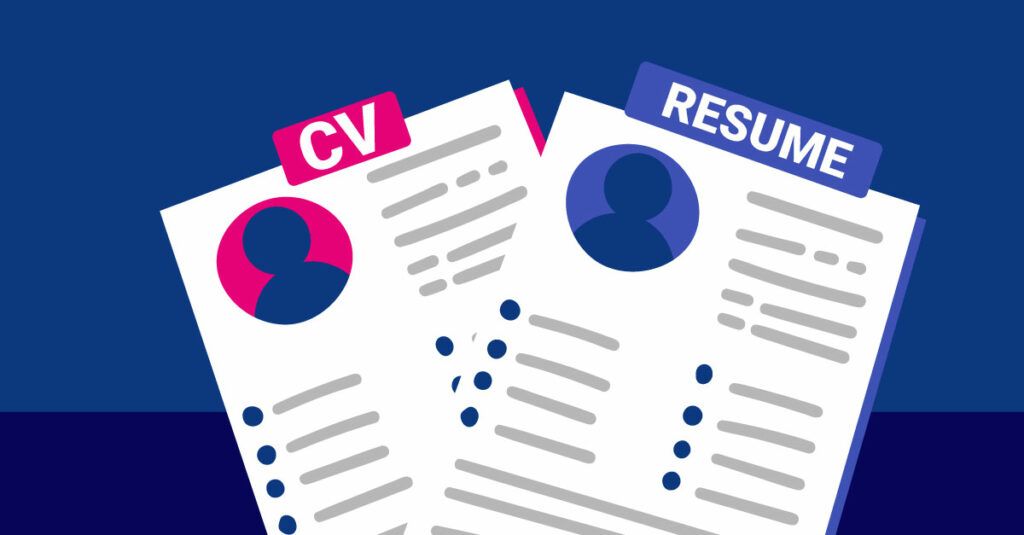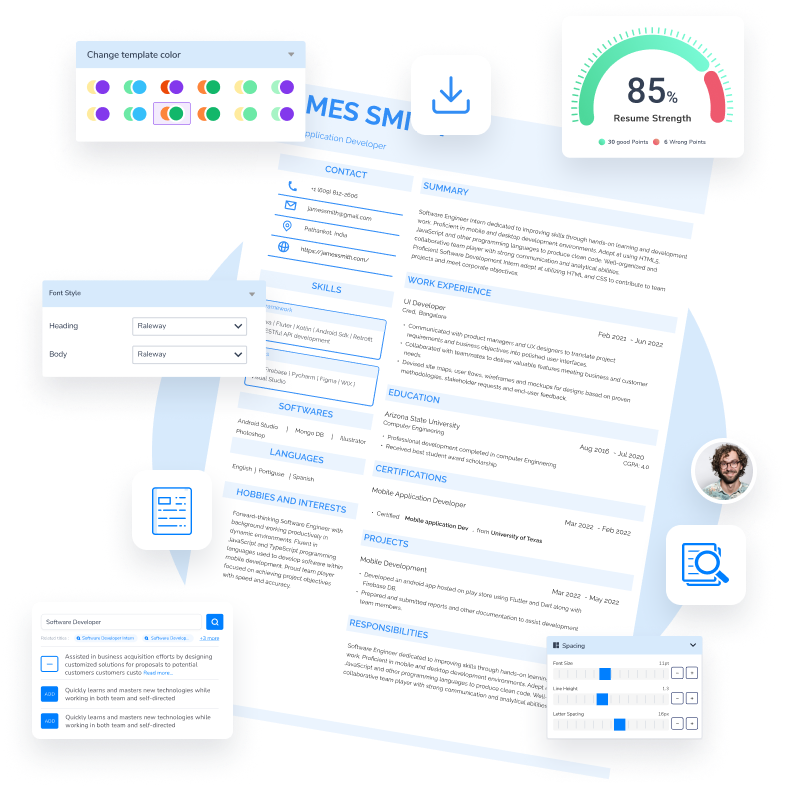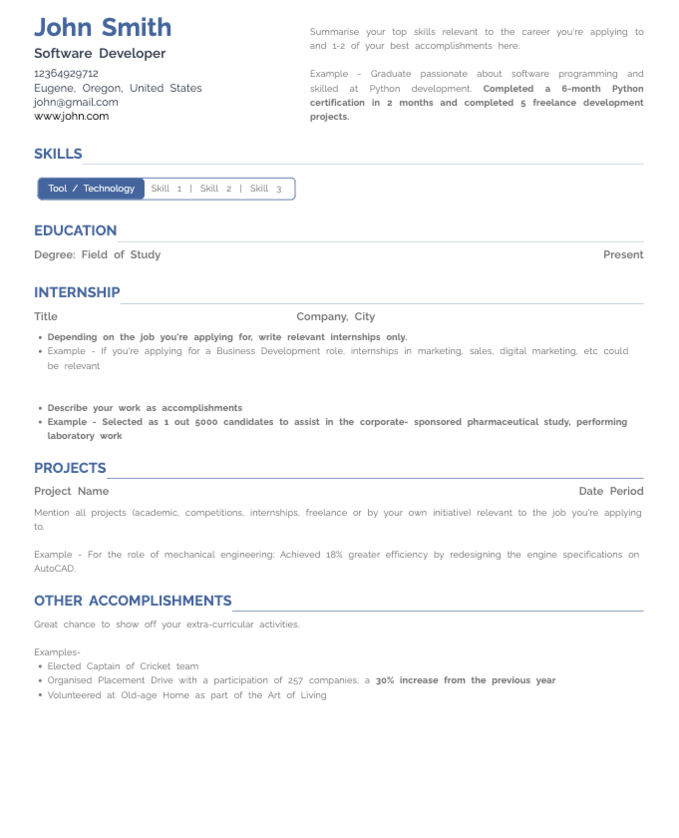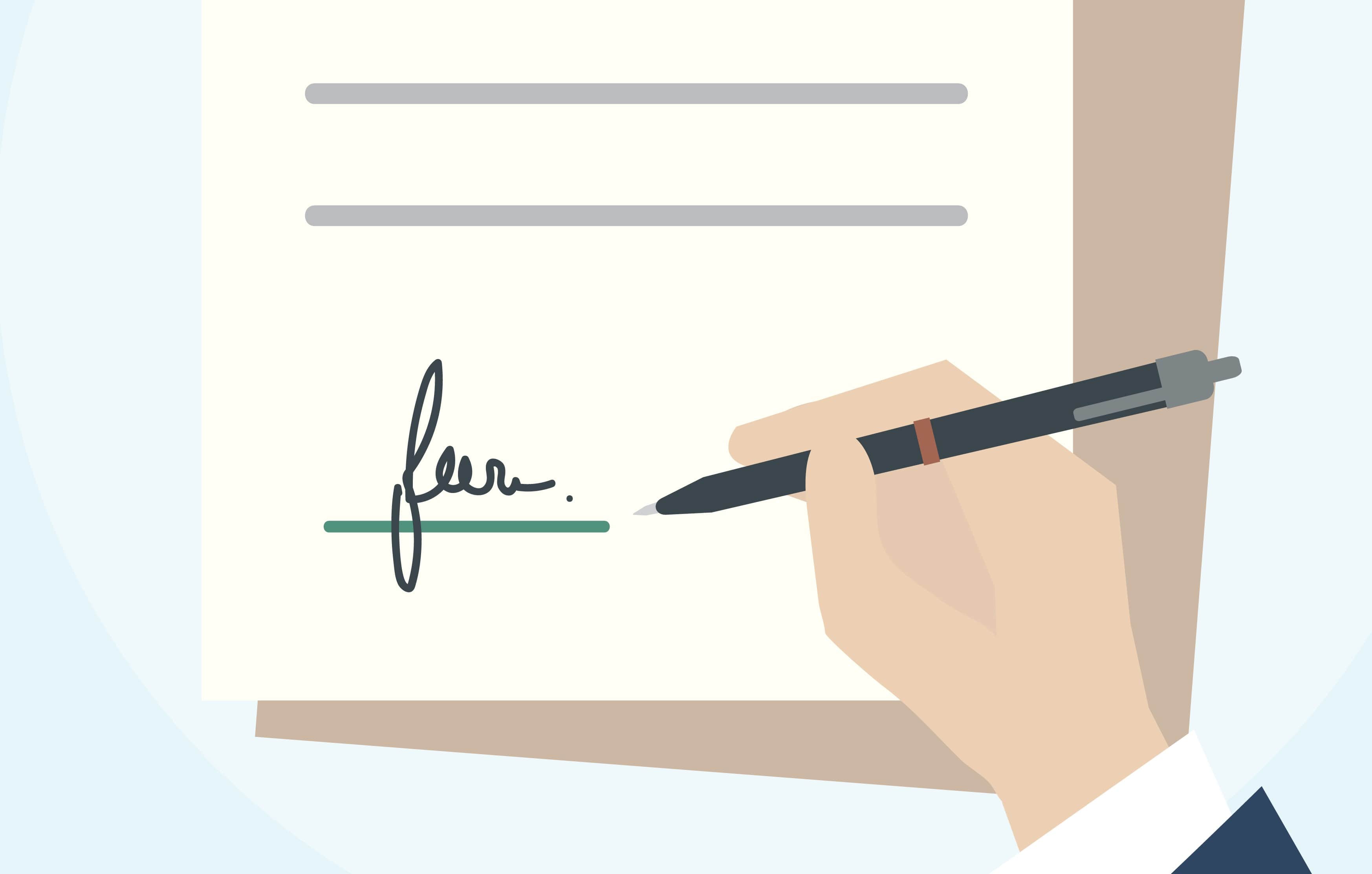10 Key Differences Between CV & Resume
8 min read

In the world of job applications and career advancement, the terms "CV" and "resume" are often used interchangeably. However, they represent distinct documents with different purposes, formats, and content.
Understanding the differences between a CV (Curriculum Vitae) and a resume is crucial for tailoring your application to specific job opportunities.
Hence, we have extracted some key differences between a CV and a Resume to help you understand their use better. You will get the answers for these questions here:
- What is a CV?
- What is a Resume?
- What is the difference between a CV and a Resume?
- How to build a professional CV?
- How to build a professional Resume?
- Is a cover letter essential with a resume or a CV?
Whether you are building a CV or a Resume, you need to research a lot and spend time. So, if you lack time and resume-building skills, we suggest you use HyreSnap Online Resume Builder. It is an easy-to-use resume making platform that is capable of building job-winning resumes in less than 15 minutes.
Let’s move ahead and explore the 10 key differences between CVs and resumes to help you navigate your career path effectively.
A CV, short for Curriculum Vitae, is a detailed document that provides an in-depth overview of a person's educational and professional background.
Unlike a standard resume, which is typically concise and focuses on a person's work experience, a CV is more comprehensive and covers a broader range of information.
CVs are commonly used in academic, scientific, medical, and research fields, as well as for certain international job applications.
Here are key features of a CV:
- Length: CVs are usually longer than resumes and can range from two to several pages, depending on the individual's experience and accomplishments.
- Content: A CV includes detailed information about a person's academic history, including degrees earned, research projects, publications, presentations, honors, and awards. It also provides a comprehensive list of work experience, including internships, teaching positions, and research positions.
- Professional Summary: Similar to a resume's objective or summary section, a CV often includes a professional summary that provides an overview of the individual's qualifications and career goals.
- Academic Achievements: CVs emphasize academic achievements, such as research conducted, dissertations or theses written, academic conferences attended or presented at, and any teaching or mentoring roles.
- Publications: It lists publications, including books, research papers, articles, and other scholarly works.
- Presentations: CVs often include a section for presentations, detailing talks, seminars, or workshops the person has given.
- Honors and Awards: It highlights academic honors, awards, scholarships, or grants received.
- Professional Associations: CVs may include memberships in professional organizations or associations relevant to the person's field.
- Skills: While not as detailed as a resume's skills section, CVs may include a brief section highlighting key skills or expertise.
CVs are typically used when applying for academic positions (such as teaching or research roles), fellowship programs, grants, and some international job opportunities.
A resume is a concise and structured document that provides an overview of an individual's education, work experience, skills, qualifications, and accomplishments.
It is typically used when applying for job positions in various industries and is the standard document for job applications in most countries, particularly in the United States and Canada.
Here are key features of a resume:
- Concise Format: Resumes are typically shorter than CVs (Curriculum Vitae) and are usually limited to one or two pages, making them a brief but focused summary of the applicant's qualifications.
- Content: A resume includes key information such as contact details, a professional summary or objective, work experience (in reverse chronological order), education, skills, and any relevant achievements or certifications.
- Professional Summary or Objective: Often located at the top of the resume, this section provides a brief statement that highlights the applicant's career goals and what they can bring to the prospective employer.
- Work Experience: This section details the applicant's employment history, typically starting with the most recent job and working backward. It includes the job title, company name, dates of employment, key responsibilities, and accomplishments for each position.
- Education: Resumes list the applicant's educational background, including degrees earned, institutions attended, graduation dates, and any relevant coursework or academic honors.
- Skills: A skills section highlights the applicant's key competencies, which can include technical skills, language proficiency, certifications, and other qualifications relevant to the job.
- Achievements: Resumes may include a section for specific accomplishments, such as awards, recognitions, or notable projects completed during previous employment.
- Customization: Resumes are often customized for each job application. This involves tailoring the content to match the specific requirements and qualifications outlined in the job posting.
- Concise Language: Resumes use concise and action-oriented language, focusing on quantifiable achievements and skills relevant to the desired position.
- Visual Presentation: The layout of a resume should be clean, organized, and easy to read. Common fonts and formatting guidelines are followed.
- References: It is generally not necessary to include references on a resume. Instead, applicants typically state that references are available upon request.
Resumes are essential tools for job seekers to present their qualifications and experiences to potential employers.
Curriculum Vitae (CV) and Resume are both documents used for job applications, but they have distinct differences in terms of content, length, and purpose.
Here are 10 key differences between a CV and a resume:
- CV: CVs are typically longer and more comprehensive. They can be several pages in length, especially for individuals with extensive academic or research backgrounds.
- Resume: Resumes are shorter and typically limited to one or two pages. They are concise summaries of an individual's qualifications.
Content
- CV: CVs include detailed information about an individual's academic background, research, publications, and teaching experience. They may also list professional associations and conferences attended.
- Resume: Resumes focus on work experience, skills, and relevant accomplishments. They are tailored to highlight the applicant's qualifications for a specific job.
Purpose
- CV: CVs are used primarily for academic, research, and scientific positions. They are also used when applying for fellowships, grants, and some international job opportunities.
- Resume: Resumes are the standard document for job applications in most industries, including business, healthcare, technology, and more.
Professional Summary/Objective
- CV: CVs may include a brief personal statement but typically do not have a specific "professional summary" or "objective" section.
- Resume: Resumes often begin with a professional summary or objective statement that provides a concise overview of the applicant's career goals and qualifications.
Work Experience
- CV: CVs include a summary of work experience, but this section is usually shorter and less detailed than on a resume.
- Resume: Resumes prioritize work experience, providing extensive details about job roles, responsibilities, and achievements.
Emphasis on Research and Publications
- CV: CVs emphasize academic research, publications, and presentations, making them essential for academic and research-related positions.
- Resume: Resumes focus on practical work experience and may include a brief section for relevant publications, particularly in fields like journalism or writing.
Skills and Certifications
- CV: CVs may include a section for technical skills and certifications, but it is typically less prominent than on a resume.
- Resume: Resumes prominently feature a skills section, highlighting the applicant's technical, soft, and job-specific skills.
References
- CV: CVs often include a list of references at the end of the document.
- Resume: Resumes typically do not include references but state that they are available upon request.
Customization
- CV: CVs are generally less customized and remain relatively static, with minor updates over time.
- Resume: Resumes are frequently customized for each job application, ensuring that the content aligns with the specific job requirements.
Geographic Usage
- CV: CVs are commonly used in Europe, Asia, Africa, and some other regions for all types of job applications.
- Resume: Resumes are the standard in the United States, Canada, and many other countries for most job applications.
Building a professional CV (Curriculum Vitae) is essential for showcasing your qualifications, skills, and experiences when applying for jobs, fellowships, academic positions, or other opportunities.
Here's a step-by-step guide on how to create a compelling CV:
Choose the Right CV Format
- Chronological CV: Lists work experience in reverse chronological order (most recent job first).
- Functional CV: Emphasizes skills and qualifications rather than work history.
- Combination CV: Blends elements of both chronological and functional formats.
Start with a Strong Header
Include your full name, professional title (if applicable), phone number, email address, and LinkedIn profile (if available).
Write a Compelling CV Objective or Summary
Provide a concise statement at the beginning that highlights your career goals, skills, and what you bring to potential employers.
Highlight Your Work Experience
List your work experience in reverse chronological order, including job titles, company names, dates of employment, and key responsibilities and achievements for each role.
Emphasize Educational Background
Include your educational history, specifying degrees earned, institutions attended, graduation dates, and relevant coursework or honors. If you have extensive work experience, you can place this section after your work experience.
Showcase Skills
Create a dedicated section to highlight your technical, soft, and transferable skills relevant to the job you're applying for.
Include Achievements
Highlight specific accomplishments, awards, recognitions, or projects that demonstrate your skills and contributions in each job or educational role.
Add Certifications and Training
List relevant certifications, courses, workshops, or training programs you've completed.
Highlight Publications and Presentations (if applicable)
If you're in academia or a research-related field, include a section for publications, research papers, articles, presentations, and conference contributions.
Mention Professional Associations
Include memberships in relevant professional organizations or associations.
Provide References (optional)
You can state that references are available upon request, or you can include them if the job posting specifically asks for them.
Use Action Words
Begin bullet points with strong action verbs to describe your accomplishments and responsibilities.
Keep It Concise
Aim for a CV length of two pages, but it can be longer if you have extensive experience. Prioritize the most relevant information.
Use a Clean and Organized Layout
Choose a professional font and ensure the layout is easy to read, with consistent formatting.
Tailor Each CV
Customize your CV for each job application by aligning it with specific job requirements and using keywords from the job posting.
Proofread Thoroughly
Eliminate spelling and grammatical errors, and ensure formatting is consistent and easy to read.
Seek Feedback
Have a mentor, professor, or trusted friend review your CV for feedback and suggestions.
Save in the Right Format
Save your final CV as a PDF file to ensure it retains its formatting when viewed on different devices.
A well-crafted CV should effectively communicate your qualifications and experiences, making a strong case for why you're the ideal candidate for a job or opportunity.
Building a professional resume is crucial for effectively showcasing your qualifications, skills, and experiences to potential employers.
Here's a step-by-step guide on how to create a compelling and professional resume:
Choose the Right Resume Format
Select a format that best suits your background and career goals. The most common formats are:
- Chronological Resume: Lists your work experience in reverse chronological order (most recent job first).
- Functional Resume: Focuses on your skills and qualifications, ideal for those with gaps in employment or changing careers.
- Combination Resume: Combines elements of both chronological and functional formats, emphasizing skills while providing a chronological work history.
Start with a Strong Header
At the top of your resume, include a header with your name, professional title (if applicable), phone number, email address, and a LinkedIn profile (if you have one).
Write a Compelling Resume Objective or Summary
Craft a concise statement that briefly summarizes your career goals, skills, and what you can bring to the prospective employer.
Highlight Your Work Experience
List your work experience in reverse chronological order, including job titles, company names, dates of employment, and key responsibilities and achievements for each role.
Emphasize Educational Background
Include your educational history, specifying degrees earned, institutions attended, graduation dates, and relevant coursework or academic honors. Place this section after your work experience if you have significant work experience.
Showcase Skills
Create a dedicated section to highlight your technical, soft, and transferable skills. Tailor these skills to match the job requirements.
Include Achievements
Highlight specific accomplishments, awards, recognitions, or projects that demonstrate your skills and contributions in each job or educational role.
Add Certifications and Training
List relevant certifications, courses, workshops, or training programs you've completed.
Use Action Words
Begin bullet points with strong action verbs to describe your accomplishments and responsibilities.
Keep It Concise
Aim for a resume length of one to two pages, prioritizing the most relevant information. Be concise and avoid unnecessary details.
Use a Clean and Organized Layout
Choose a professional font and ensure the layout is easy to read, with consistent formatting, such as bullet points and headings.
Tailor Each Resume
Customize your resume for each job application by aligning it with specific job requirements and using keywords from the job posting.
Proofread Thoroughly
Eliminate spelling and grammatical errors, and ensure formatting is consistent and easy to read. Consider seeking feedback from a trusted friend or mentor.
Save in the Right Format
Save your final resume as a PDF file to ensure it retains its formatting when viewed on different devices.
Whether a cover letter is essential with a resume or CV depends on several factors, including the industry, job application requirements, and personal preferences. Here are some considerations to help you decide when to include a cover letter:
When to Include a Cover Letter:
- Job Application Requires It: If the job posting explicitly requests a cover letter, it is essential to include one. Ignoring this requirement may result in your application being disqualified.
- Opportunity to Explain: A cover letter provides an opportunity to explain aspects of your qualifications and experiences that might not be evident from your resume or CV. It allows you to make a compelling case for why you're the ideal candidate.
- Show Enthusiasm: A well-crafted cover letter allows you to express your enthusiasm for the job and the company. It demonstrates that you've taken the time to research the organization and are genuinely interested in the position.
- Address Employment Gaps or Career Changes: If you have employment gaps or are changing careers, a cover letter can help you address these aspects and provide context.
- Highlight Specific Achievements: Use a cover letter to emphasize specific achievements or skills that are directly relevant to the job you're applying for.
- Personalize Your Application: A cover letter can be tailored to each job application, allowing you to address the hiring manager by name and demonstrate that you've carefully considered how your qualifications match the job requirements.
When a Cover Letter May Not Be Necessary:
- Not Requested: If the job posting does not mention a cover letter and explicitly asks for a resume or CV only, it may not be necessary to include one. Some employers have a clear preference for resumes and CVs only.
- Highly Standardized Applications: In some industries where applications are highly standardized, such as online job applications using applicant tracking systems (ATS), the focus may be primarily on the resume or CV. In such cases, additional documents like cover letters may not be considered.
- Limited Relevant Information: If you believe that a cover letter would not add significant value to your application because your qualifications and experiences are well-documented in your resume or CV, you might choose to forgo it.
Resume building is not a cup of tea for every professional as it needs focus, modern skills, and time. If you have scarcity of any of them, use HyreSnap Online Resume Builder. It is a marvelous AI tool that can generate impeccable resumes in minutes.
Have a look at the major offerings of this modern resume building platform:
We have listed all the key differences between a CV and a resume above to help you understand the application of both documents in your career-building process. For additional career-building assistance, please contact our experts at info@hyresnap.com.

Try Now for Free!




